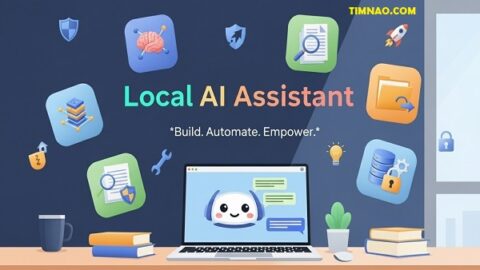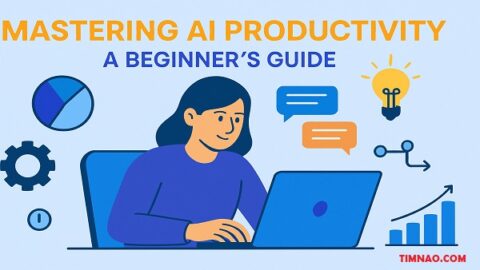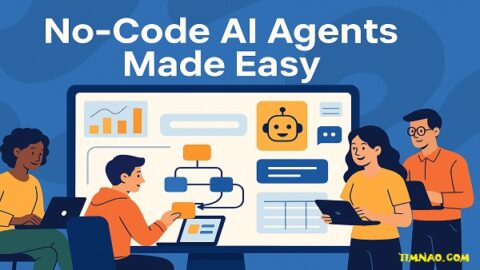AI in Psychology Monetization: 27 Proven, High-Impact Paths to Profit 🚀
AI in psychology monetization is no longer a futuristic concept—it’s one of the most exciting, fast-growing opportunities for creators, professionals, and entrepreneurs today. As artificial intelligence transforms mental health, education, behavior science, and clinical care, a new wave of business models is emerging. Whether you’re a therapist looking to scale your practice, a researcher hoping to commercialize your expertise, or a startup founder exploring digital health, the potential to turn psychological knowledge into real revenue has never been bigger.
This guide is designed to bridge the gap between theory and practice. We’ll go far beyond definitions and show you exactly how to make money using the insights, tools, and frameworks from modern AI psychology—step by step. You’ll learn which business ideas are actually working, how to price them, what tools to use, and how to launch a product or service in just a couple of weeks. Even if you’re a complete beginner, you’ll walk away with a roadmap to start small, scale confidently, and stay compliant with privacy and ethics standards.
Ready to turn psychological insight into income? Let’s dive in. 🚀
Read this first: If you’re new to AI and psychology, this guide turns what you learned from AI Applications in Psychology into practical, money-making plays. You’ll get beginner-friendly explanations, step-by-step launch plans, pricing ideas, and the exact tools to ship a minimum viable product (MVP) without writing much code. We’ll also bake in ethics, privacy, and compliance so your revenue grows on solid ground.
Table of Contents
- 💡 The Opportunity: Why Now for AI in Psychology
- 🧰 Beginner Playbook: What You Need (and Don’t)
- 💸 27 Monetization Models You Can Launch This Quarter
- ⏱️ Fast-Track MVP: A 14-Day Build Plan
- 💵 Pricing, Unit Economics & Money Math
- 🧲 Go-to-Market: How to Get Your First 10 Paying Customers
- 🛡️ Safety, Ethics & Compliance as a Competitive Edge
- 📊 Metrics That Matter: 30/60/90-Day Scorecard
- 🧪 Case-Style Examples You Can Borrow Today
- 🙋 FAQs: Beginner Questions About AI in Psychology Monetization Answered
- ✍️ Key Lessons & Takeaways
💡 The Opportunity: Why Now for AI in Psychology
AI in psychology monetization isn’t a distant dream anymore—it’s a practical path for therapists, educators, researchers, and creators who want to turn expertise into income while helping people at scale. The demand for faster access, personalized support, and clear outcomes keeps rising, and modern AI tools finally make it possible to build useful products without a big team or a giant budget. If you can connect real human pain points to simple, ethical solutions, there’s room for you.
Market Demand & Buyer Pain Points
People and organizations are overwhelmed by stress, burnout, and access gaps. Long waitlists, limited coverage, and geographic barriers mean many never receive timely help. That’s where AI-enabled services shine: they extend reach, complement clinicians and educators, and provide continuity between sessions or classes.
Here’s what buyers are actively looking for:
- Faster intake and triage: Clinics and programs want to prioritize who needs help first, with a human in the loop.
- Affordable, always-on coaching: Individuals want practical skills and motivation between appointments.
- Personalized learning: Schools, tutoring companies, and learning centers want adaptive assessments that reduce test fatigue and improve accuracy.
- Actionable wellbeing analytics: Employers want privacy-safe trends (not personal dossiers) to protect teams and reduce churn.
- Scalable programs: Leadership wants interventions that work for dozens, then hundreds, then thousands—with stable costs.
The key for beginners: focus on a narrow, high-friction moment (no-shows, first-year student stress, shift-worker sleep) and solve it measurably.
Tech & Policy Tailwinds (Tools, Guidance)
Five practical shifts lowered the barrier to entry:
- Friendly AI models: Chat-style tools from OpenAI, Anthropic, and Google let you analyze text, draft content, and build guided conversations in hours.
- No-code plumbing: With Zapier and Make, you can pass data between forms, spreadsheets, and dashboards without writing custom servers.
- Cheap, flexible storage: Google Sheets or Airtable handle early pilots just fine—simple, auditable, and easy to share.
- Transparent privacy expectations: Buyers now expect plain-language consent, opt-in for sensitive data, and clear deletion schedules. When you deliver those by default, you remove objections.
- Cultural comfort with digital help: People accept AI as a supplement, not a replacement—especially when there’s a visible human safety net.
Together, these tailwinds mean you can build and prove value fast, then formalize the tech as you scale.
What Buyers Actually Pay For (Outcomes Over Algorithms)
People don’t buy “AI.” They buy outcomes. Anchor your product to one of these results:
- Time saved: Fewer admin hours or faster routing (e.g., triage that stacks cases for review).
- Cost reduced: Shorter assessments, fewer no-shows, lower churn.
- Better decisions: Risk scores or readiness indicators that guide attention.
- Improved outcomes: Lift in retention, learning gains, mood stability, or sleep regularity.
- Personalization at scale: Right content, right time, right tone—without hiring ten more staff.
Frame everything in terms of the before → after story: “Before, managers guessed. After, they act weekly on three clear insights.”
Positioning That Works for Beginners
You don’t need to be the most advanced. You need to be the clearest and the safest choice.
- Sell a promise you can deliver in 2–4 weeks. Example: “Cut no-shows by a few percentage points” beats “Reinvent mental healthcare.”
- Be privacy-first. Explain what you collect, what you never collect, where data lives, who sees it, and when it’s deleted.
- Human-in-the-loop, always. Automated flags → human review → supportive action.
- Explainability in plain English. For any flag, provide 2–3 reasons a non-expert understands.
- Outcome-linked pricing. When possible, share risk with the buyer (e.g., success bonus for fewer no-shows).
This posture wins trust, accelerates procurement, and reduces churn.
Quick Wins You Can Launch This Month
- Anonymous wellbeing snapshots for a single team (≤200 people): Four-question weekly check-in + one-page dashboard in Looker Studio.
- Adaptive micro-quiz for onboarding or studying: Ten items that get harder/easier; weekly gap report for instructors.
- No-show reduction for a small clinic: Simple risk rules from recent attendance + automatic reminder flows.
- Coaching companion for shift workers: A chatbot that teaches three skills (reframe, breathing, sleep routine) with a crisis disclaimer and local resources.
Pick one. Prove it. Then reuse the same plumbing for a second cohort.
From Opportunity to Toolkit
You’ve seen where the demand is and why now is different. The next step is practical: what exactly do you need to build a trustworthy, lightweight, launch-ready solution? Let’s assemble your beginner toolkit.
🧰 Beginner Playbook: What You Need (and Don’t)
You don’t need a data center, a research grant, or a senior engineering team. You need a clean workflow, clear boundaries, and the right small tools working together. Build the first version so simple that your buyer understands it in one minute—and your future self can maintain it without headaches.
No-Code Stack (Surveys, Dashboards, LLMs, Automation)
Start with tools that get you from idea to demo in a weekend:
- Surveys & check-ins: Typeform or Google Forms for quick, mobile-friendly inputs.
- Data store: Google Sheets or Airtable to keep early pilots auditable and sharable.
- Dashboards: Looker Studio or Retool for clean visuals, trends, and red flags.
- AI text & summaries: ChatGPT, Claude, or Gemini to cluster themes and draft weekly insights (you review before sending).
- Automation glue: Zapier or Make to connect everything without writing backend code.
- Opt-in wearables (optional): Fitbit or Garmin for sleep/activity trends with explicit permission.
- Transcription (optional): Otter.ai if you’re analyzing de-identified notes or group reflections.
Use the smallest set of tools that can deliver your promise. Fewer moving parts = fewer data risks and easier maintenance.
Data Policy & Plain-Language Consent
Trust is your brand. Before you collect a single response, write a one-page policy in human language:
- Purpose: What value the user gets (e.g., insights to reduce burnout) and what value the organization gets (e.g., group-level trends).
- Data minimization: Exactly what you collect—and what you never collect.
- Storage & access: Where data lives, how it’s protected, and who can see it.
- Retention & deletion: How long you keep data and when you delete it automatically.
- Limits & emergencies: Clear statement that you do not provide crisis care; include local resources and escalation steps.
Put this policy on your landing page, in your intake form, and in every proposal. It lowers friction and positions you as the safe, sensible choice.
Privacy-by-Design: Minimize, De-Identify, Delete
Operationalize privacy so it’s not a one-time promise but a routine:
- Collect less. Start with four or five compact questions; add more only when needed.
- De-identify early. Replace names/emails with coded IDs; keep the key in a separate, access-controlled location.
- Aggregate by default. Most stakeholders need group trends, not individual profiles.
- Limit access. Only two people (max) should view raw data in a pilot.
- Auto-delete. Set a calendar reminder or automation to remove data after the agreed period.
- Opt-out anytime. Make it easy and visible.
Remember: privacy details are selling points. Put them in your marketing, not just your legal docs.
Scope Your First Build (2–4 Weeks)
Don’t start with “reinventing care.” Start with one measurable promise:
- Pick a narrow outcome. Examples: reduce no-shows modestly, spot early student stress, or shorten assessments by a few minutes.
- Define a tiny input set. Four questions + one open text box is plenty to demonstrate value.
- Decide your red flags. Two to three conditions that trigger a human review or a helpful nudge.
- Draft your weekly report. One page: trends, top themes, and three recommended actions.
- Set success criteria. What would count as “this is working” after 2–4 weeks?
If you can’t explain the entire plan to a non-technical leader in 60 seconds, simplify again.
A Simple MVP Architecture (Beginner-Friendly)
Think of your MVP as a straight line, not a spider web:
- Form → user submits 4–5 items (plus optional open text).
- Sheet/Database → responses land in a structured table.
- Automation → a trigger runs weekly to create summaries and update your dashboard.
- LLM Summaries (optional) → clusters top themes from open text (you review for tone and accuracy).
- Dashboard → shows trend lines, participation rates, and red flags.
- Human Review → a named person reads the flagged items (if any) and decides on next steps.
- Feedback Loop → share simple, non-judgmental insights and a specific action suggestion.
This straight line is easy to audit and easy to improve.
Templates & Scripts You Can Steal
- Four-question check-in:
- “How was your overall mood this week?” (0–10)
- “How stressful was your week?” (0–10)
- “How would you rate your sleep quality?” (0–10)
- “Did you feel adequately supported?” (Yes/No)
Open text: “Anything we should know?”
- Plain-language consent snippet:
“We collect a small set of answers each week to show group-level trends (not individual profiles). Your participation is optional. You can opt out anytime. We don’t provide emergency services; if you need immediate help, please contact local crisis resources listed here.” - Flag explanation format (use for any alert):
- “We flagged this week due to: (a) sleep deteriorated vs. last week, (b) stress stayed high, (c) notable negative wording in comments. A human will review and, if appropriate, suggest a small next step.”
- Weekly report outline (one page):
- Participation: % and week-over-week change
- Top 3 themes (in plain English)
- 3 recommended actions (aligned with what leaders can change this week)
- Notes on privacy & opt-out link (always visible)
Common Mistakes (and How to Avoid Them)
- Collecting too much data too soon: Start small; you can add inputs after trust is built.
- Automating decisions: Keep humans in the loop for any sensitive outcome. AI assists, humans decide.
- Opaque scoring: Scores without reasons feel spooky. Provide two or three reasons anyone can understand.
- Ignoring bias checks: If performance differs across groups, pause and adjust data or scope.
- Overpromising: “We’ll cure burnout” is a trust killer. Promise small, deliver consistently, then scale.
- Forgetting deletion: Put a recurring reminder in your calendar or make deletion automatic via automation tools.
A trustworthy small solution beats an ambitious, fragile one—every time.
What to Do Next
By now you have the tools, the policy guardrails, and a practical architecture for a first build. The next logical step is to choose a specific monetization lane and shape your MVP into a paid package with clear pricing and outcomes. When you’re ready, we’ll map 27 ready-to-go business models and show you how to package, price, and sell your first contract with confidence.
💸 27 Monetization Models You Can Launch This Quarter
You don’t need a giant platform or a research lab to turn psychological insight into income. With today’s AI tools and no-code apps, you can build tiny, trustworthy services that solve clear problems — and people will pay for them. This section gives you 27 beginner-friendly models you can launch this quarter. For each idea, you’ll see what it is, how to ship a minimum viable version fast, starter pricing, and the key metric to prove value. Pick one lane, launch small, then reuse your plumbing to scale.
🏢 B2B: Organizations, Schools, and Clinics
B2B buyers care about outcomes: fewer no-shows, better retention, less burnout, faster triage. Keep your offer privacy-first, human-in-the-loop, and result-oriented.
1) Anonymous Wellbeing Dashboard
- What it is: Weekly 4-question check-ins rolled up to a group dashboard; no individual profiling.
- How to launch: Forms with Typeform or Google Forms; automate summaries via Zapier + ChatGPT; visualize in Looker Studio.
- Starter pricing: $1,000–$3,000/month per 200–500 people.
- Prove it: Participation rate ≥60%; one actionable insight per week; manager satisfaction survey.
2) “Voice of Staff/Students” NLP Pulse
- What it is: Quarterly analysis of open comments to surface themes, sentiment, and risks.
- How to launch: Export comments → cluster with Claude or GPT → deliver a 4-page action brief.
- Starter pricing: $2–$5 per person/quarter or $2,000/project.
- Prove it: Three changes implemented from your brief; follow-up sentiment improves next quarter.
3) Adaptive Assessments for Hiring & Training
- What it is: 8–12 item quizzes that get easier/harder; cut test fatigue and sharpen decisions.
- How to launch: Item bank in Airtable; logic in Bubble or Retool; bias checks in your report.
- Starter pricing: $10–$20 per candidate + setup fee.
- Prove it: Shorter time-to-hire and higher pass-rate predictiveness at probation review.
4) Smart Triage for Clinics
- What it is: Intake form + NLP flags routed to a clinician with plain-English reasons.
- How to launch: Form → sheet → rule-based flags; keep a human reviewer; include crisis boundaries.
- Starter pricing: $500–$2,000/month + usage fees.
- Prove it: Median intake-to-appointment time down; clinician agreement with flags ≥80%.
5) Predictive No-Show Prevention
- What it is: Forecast who might miss an appointment; trigger reminders or easy rescheduling.
- How to launch: Train a simple model on attendance history; send SMS/email nudges via automation tools.
- Starter pricing: $1,500 setup + $500/month; optional success bonus.
- Prove it: No-shows drop 5–15%; recovered revenue documented monthly.
6) Burnout Early-Warning for Support Teams
- What it is: Weekly micro-check-ins + workload metadata to flag rising risk at team level.
- How to launch: Minimal survey; trend lines in Looker; “red-flag” rules managers can act on.
- Starter pricing: $2,000/month per 200 agents.
- Prove it: Absenteeism down; voluntary attrition down; manager action logs.
7) First-Year Student Resilience Program
- What it is: Semester program mixing micro-lessons, adaptive checks, and check-ins.
- How to launch: Content hub in Notion or LMS; weekly nudges; advisor dashboard.
- Starter pricing: $5–$15 per seat/semester.
- Prove it: Early-alert outreach up; first-year retention +1–2%.
8) Debrief & Reflection Analytics
- What it is: Analyze anonymized debrief notes to spot recurring stressors and training gaps.
- How to launch: Secure upload; topic clustering; monthly practice changes summarized for leaders.
- Starter pricing: $3,000/department/quarter.
- Prove it: Fewer repeat incidents linked to targeted interventions.
9) Wellbeing Index API for HR Vendors
- What it is: A privacy-light 0–100 score from minimal inputs (e.g., mood and sleep regularity).
- How to launch: Host a simple endpoint; document inputs/outputs; include fairness notes.
- Starter pricing: $0.01–$0.05 per call; enterprise tier available.
- Prove it: Partner adoption; support tickets low; uptime SLA met.
10) Psychoeducation Micro-Library (Licensing)
- What it is: 2–5 minute lessons on stress, sleep, and focus; license to orgs.
- How to launch: Record screen-casts; add transcripts; bundle by theme.
- Starter pricing: $2,500/year/site.
- Prove it: Course completion rates; manager feedback; reduced EAP spikes.
👤 B2C: Direct-to-Consumer Products
B2C thrives on clarity, affordability, and habit loops. Keep onboarding fast and benefits obvious.
11) Micro-CBT Coach
- What it is: A friendly chatbot teaching reframing, breathing, and sleep basics; not for emergencies.
- How to launch: Conversation flows with GPT; streaks and tiny wins; local help links.
- Starter pricing: $3–$7/month.
- Prove it: Day-30 retention ≥35%; mood self-ratings trend upward.
12) Adaptive Study Companion
- What it is: Personalized drills for exams or languages; short, daily sessions.
- How to launch: Item bank + spaced repetition; weekly report emails.
- Starter pricing: $9–$15/month or per-course fee.
- Prove it: Quiz accuracy up; time-on-task steady; trial-to-paid conversion.
13) Digital Habit Builder
- What it is: Just-in-time nudges aligned to user rhythms; gentle gamification.
- How to launch: Phone-friendly prompts; habit stacking; private streaks.
- Starter pricing: $6–$10/month.
- Prove it: Consecutive-day adherence; self-reported energy/focus gains.
14) Parenting Micro-Lessons Hub
- What it is: Bite-size guidance on screen-time, sleep, and stress for kids/teens.
- How to launch: 60-minute course bundles; printable checklists; Q&A webinars.
- Starter pricing: $49 per bundle or $99/year.
- Prove it: Completion rates; repeat purchases; NPS from parents.
15) Focus & Productivity Toolkit
- What it is: Timers, “if-then” plans, and cognitive strategies tailored to goals.
- How to launch: Clean mobile UI; weekly focus audit; downloadable playbooks.
- Starter pricing: $29–$99 one-time or $5/month.
- Prove it: Sessions completed per week; self-rated distractions down.
🔬 Research & Clinical Services
Great for practitioners and academics who prefer service revenue over building a full SaaS.
16) De-Identified Transcript Coding & Progress Summaries
- What it is: Thematic coding of session transcripts; weekly clinician-ready summaries.
- How to launch: Consent language; anonymize early; label with controlled taxonomy.
- Starter pricing: $1–$3 per audio minute + $500/month dashboard.
- Prove it: Clinician time saved; perceived accuracy of themes; adherence to protocols.
17) EEG/MRI Analysis Pipelines
- What it is: Semi-automated segmentation/classification for neuro datasets.
- How to launch: Reproducible notebooks; QC checks; training for staff.
- Starter pricing: $3,000–$15,000/project.
- Prove it: Turnaround time cut; inter-rater agreement improved.
18) Responsible-AI Training for Clinics & People Ops
- What it is: 1–2 day workshop on privacy, bias, explainability, and escalation rules.
- How to launch: Slides + exercises; sample consent forms; model cards.
- Starter pricing: $3,000–$8,000/cohort.
- Prove it: Policy adoption; audit findings reduced; staff confidence up.
19) Outcome-Linked Coaching Programs
- What it is: 8–12 week program with fees partly tied to outcomes (e.g., absenteeism down).
- How to launch: Pre/post measures; clear playbooks; manager syncs.
- Starter pricing: $10–$30 per participant/month + success bonus.
- Prove it: Before-after delta on target metric; renewal rate.
20) Evidence & Policy Briefs for Leadership
- What it is: 15–25 page decision guides comparing options and risks.
- How to launch: Executive summary; cost-benefit; governance checklist.
- Starter pricing: $5,000/brief.
- Prove it: Decisions made; timeline acceleration; repeat engagements.
📦 Content, Templates & API Products
Low-maintenance, scalable, and perfect for solo creators or small teams.
21) Paid Newsletter (AI Psychology & Ethics)
- What it is: Weekly breakdowns of tools, case studies, and pitfalls.
- How to launch: Editorial calendar; consistent voice; member Q&A.
- Starter pricing: $10–$20/month.
- Prove it: Open rates; paid conversion; churn under 5% monthly.
22) Template Packs (Consent, Model Cards, Bias Audits)
- What it is: Ready-to-use docs teams customize in minutes.
- How to launch: Google Docs/Notion templates; examples; short video walkthroughs.
- Starter pricing: $49–$199 per pack.
- Prove it: Sales velocity; bundle attach rate; testimonials.
23) Micro-Course Marketplace
- What it is: One-hour courses with checklists and assignments.
- How to launch: Host on Gumroad/Teachable; cohort launch every 6–8 weeks.
- Starter pricing: $29–$79/course or membership tier.
- Prove it: Completion; reviews; upsell to workshops.
24) Nudge or Assessment Item API
- What it is: Returns a “next best nudge” or quiz item based on minimal inputs.
- How to launch: Simple REST API; developer docs; sandbox keys.
- Starter pricing: $0.01–$0.05 per call; free tier.
- Prove it: DAU of integrators; API error rate; revenue per 1,000 calls.
25) AI-Drafted Assessment Item Generator (Human-Reviewed)
- What it is: Drafts question stems, distractors, and rationales; humans approve.
- How to launch: Template prompts; reviewer workflow; export to LMS.
- Starter pricing: $1–$3 per item + review fee.
- Prove it: Item rejection rate; time saved per 100 items.
26) Clinic Operations Copilot
- What it is: Automates reminders, summaries, and follow-ups — admin only, not diagnosis.
- How to launch: Connect calendar/EMR (where allowed); pre-approved templates.
- Starter pricing: $199–$499/month per clinic.
- Prove it: No-show drop; admin hours saved; staff satisfaction.
27) Fractional AI Ethics Advisor
- What it is: A monthly retainer to review consent, data flows, and fairness tests.
- How to launch: Intake questionnaire; quarterly audits; hotline hours.
- Starter pricing: $1,000–$2,500/month.
- Prove it: Audit issues reduced; faster approvals; board sign-off.
✅ Choosing the Right Model for You
You don’t need permission to start — you need fit. Use this quick picker to choose a lane you can deliver in 2–4 weeks:
- I’m short on time: Start with Template Packs, a Paid Newsletter, or a Micro-Course. You can build once and sell repeatedly.
- I want recurring B2B revenue: Ship Anonymous Wellbeing Dashboards, NLP Pulse, or No-Show Prevention — they tie neatly to outcomes and renewals.
- I’m a practitioner or researcher: Offer Transcript Coding, EEG/MRI Pipelines, or Evidence Briefs — high trust, clear value, premium pricing.
- I love building tools: Create APIs, an Assessment Item Generator, or a Clinic Copilot — usage-based revenue scales with adoption.
Whatever you pick, write a one-page plan: the problem, the audience, the smallest data you need, the output you’ll deliver weekly, and the single metric that proves you’re useful. If that page isn’t crystal clear to a non-technical buyer, simplify until it is.
🔄 From Ideas to Implementation
Ideas don’t close deals — clear pilots do. In the next section, we’ll turn your chosen model into a working product with a 14-day build plan. You’ll define success criteria, set up consent and privacy by design, connect your no-code tools, and deliver a before-after report that makes signing a paid contract the obvious next step.
⏱️ Fast-Track MVP: A 14-Day Build Plan
Building a psychology-powered AI product doesn’t have to take months or a big engineering team. In fact, one of the most effective ways to attract clients — and get them to pay — is by launching a Minimum Viable Product (MVP) in just two weeks. Your MVP is not a full product. It’s a lean, testable version that solves a small, specific problem and shows measurable value. Once people see results, they’ll often pay for ongoing access or custom development.
Here’s a beginner-friendly roadmap for turning one of the monetization models we discussed into a functioning product — even if you’re not a coder.
Day 1–2: Choose One Problem and Define Success
Before writing a single line of code or designing a logo, answer two critical questions:
- What pain point are you solving?
Pick one clear outcome such as reducing no-shows, improving student retention, or identifying early burnout signals. - How will you measure success?
Define a single, simple metric — for example:- Reduce missed appointments by 10%
- Achieve a 60% weekly survey participation rate
- Flag 5 at-risk students before midterm
Pro tip: Resist the urge to solve multiple problems at once. A narrow, specific goal is far more attractive to early adopters.
Day 3–4: Map the Data and Draft Consent
AI products rise or fall on trust, especially in psychology. Before collecting anything, plan your data strategy.
- Collect only what’s essential. If you’re predicting burnout, you might only need weekly mood scores, sleep patterns, and stress levels.
- Anonymize early. Replace names with user IDs and remove identifiable details.
- Draft plain-language consent. Explain:
- What data you collect
- Why you’re collecting it
- How you’ll store and delete it
- How users can opt out
✅ Example consent snippet:
“We collect short, anonymous check-in responses to help your organization understand overall wellbeing trends. We do not track individual employees, and all data is automatically deleted after 60 days.”
Day 5–7: Build the Basic Workflow (No-Code Tools)
Your MVP should follow a simple three-step process: Collect → Analyze → Present. Here’s how to build that using free or affordable tools:
- Collect data:
- Use Google Forms or Typeform for surveys.
- Offer optional integrations with Fitbit or Garmin for wearables.
- Analyze data:
- Send data to a Google Sheet or Airtable.
- Use Zapier or Make to trigger summaries via ChatGPT or Anthropic Claude.
- Visualize results:
- Use Looker Studio or Retool to build dashboards.
- Add filters and trend lines so users can explore the data themselves.
Keep the design simple. You’re not building a finished app — just a useful demo that answers one question clearly.
Day 8–10: Automate Signals and Human Review
AI can help you surface insights, but a human should always make the final call — especially when dealing with psychological data.
- Set thresholds: For example, flag users with a mood score below 3 for three consecutive weeks.
- Create explanations: Instead of a raw score, provide a short explanation:
- “Mood has declined by 40% since last month.”
- “Self-reported stress is consistently high for 14 days.”
- Add a human-in-the-loop: Route flagged cases to a manager, counselor, or coach for review before taking action.
This balance builds trust and reduces the risk of false positives.
Day 11–12: Package and Price the MVP
Now that your MVP works, it’s time to make it look like a product.
- Create a one-page summary describing:
- What the tool does
- How it works
- What outcomes it delivers
- Pricing and next steps
- Offer two pricing tiers:
- Starter: Small teams or pilot projects (e.g., $500/month for up to 200 users)
- Growth: Larger organizations with custom features (e.g., $2,000/month for 1,000+ users)
Pro tip: Include a success-based clause (“10% bonus if no-shows drop by more than 15%”) — it shows confidence and aligns incentives.
Day 13–14: Run a Pilot and Collect Feedback
Find one willing pilot customer — a small clinic, HR team, or school department — and launch your MVP for free or at a discount. During this phase:
- Measure outcomes based on your original goal.
- Collect user feedback about what’s working and what isn’t.
- Document a success story to use in your marketing.
After two weeks, you’ll have a working product, proof of value, and the beginnings of your first paying contract.
💵 Pricing, Unit Economics & Money Math
You can build the most brilliant product in the world, but if your pricing doesn’t make sense, your business won’t scale. Understanding basic pricing strategy and unit economics will keep you profitable from day one.
The 3 Golden Rules of Pricing
- Price the outcome, not the feature.
Don’t sell “an AI dashboard.” Sell “10% fewer missed appointments.” - Make it easy to say yes.
If your price is less than 10–20% of the problem’s cost, clients will see it as a no-brainer. - Use anchors and tiers.
Offer at least two plans (Starter and Growth) so buyers have a comparison.
B2B Pricing Benchmarks
| Model | Starter Plan | Growth Plan | Common Add-Ons |
|---|---|---|---|
| Wellbeing dashboard | $1,000/mo | $3,000+/mo | Custom surveys, integrations |
| NLP feedback analysis | $2,000/project | $10,000+/year | Sentiment over time |
| Adaptive testing | $10–$20 per test | Enterprise bulk pricing | Custom benchmarks |
| Smart triage | $500–$2,000/mo | $5,000+/mo | Crisis routing, EHR sync |
| No-show prevention | $1,500 setup + $500/mo | $2,000+/mo | Automated reminders |
✅ Pro tip: Offer a small discount for annual contracts — they lock in predictable revenue and build trust.
B2C Pricing Benchmarks
| Product | Pricing | Monetization Options |
|---|---|---|
| CBT chatbot | $3–$7/month | Premium features, coaching upsells |
| Study app | $9–$15/month | Course bundles, tutor marketplace |
| Habit builder | $6–$10/month | Affiliate revenue, premium plans |
| Parent lessons | $49–$99 | Subscription or lifetime access |
| Focus toolkit | $29–$99 | Tiered features, group licenses |
Understanding Unit Economics
1. Customer Acquisition Cost (CAC):
How much you spend to acquire a new customer. Early on, aim to keep CAC below one month of subscription revenue.
2. Customer Lifetime Value (LTV):
How much revenue a customer brings in over their entire relationship with you. A healthy business typically has LTV ≥ 3× CAC.
3. Gross Margin:
The percentage of revenue left after direct costs. For digital products, aim for 70–90%.
4. Payback Period:
How long it takes to recover your acquisition cost. The shorter the better — under 3 months is ideal.
Example:
- CAC: $100
- Subscription: $30/month
- Churn: 5%/month (average lifetime ~20 months)
- LTV: $30 × 20 = $600
✅ LTV/CAC = 6 → Very healthy business.
🧲 Go-to-Market: How to Get Your First 10 Paying Customers
Building a great product is only half the battle. The other half? Getting real people to pay for it. Your first 10 customers are crucial — they validate your product, give you feedback, and generate early revenue. Here’s how to win them.
Step 1: Leverage Warm Networks
Your first customers are probably already in your network. Start with:
- Former colleagues who run teams or programs.
- Professors or researchers who could use your tools.
- Therapists or clinic owners you know personally.
Send a short message like:
“Hey [Name], I’m testing a new tool that helps clinics reduce no-shows using AI. It’s free for the pilot. Can we chat for 15 minutes this week?”
This approach is low-risk for them and often converts to paying clients later.
Step 2: Run a Value-First Email Campaign
Write a 3-email sequence focused on solving problems — not selling features:
- Email 1 – Problem: “Why 40% of clinics lose revenue to no-shows.”
- Email 2 – Solution: “How AI can cut cancellations by 15%.”
- Email 3 – Offer: “Pilot our system free for 30 days.”
Aim for a 20–30% open rate and 5–10% reply rate.
Step 3: Post on LinkedIn — with Purpose
Three types of LinkedIn content consistently generate leads:
- Outcome stories: “We reduced missed sessions by 17% last month.”
- Behind-the-scenes: “Here’s how we built a triage system without writing code.”
- Mini-education: “3 psychology-backed nudges that boost engagement.”
End each post with a soft call-to-action:
“DM me if you want to see a quick demo.”
Step 4: Offer a “Pilot, Not a Pitch”
Instead of asking people to “buy,” ask them to pilot. This lowers risk and speeds up decision-making.
- Make the pilot free or heavily discounted.
- Keep it short (2–4 weeks).
- Define success metrics in advance.
When they see results, most will convert to paid plans.
Step 5: Create a Referral Loop
After your first few customers, make referrals part of your growth engine:
- Offer one free month for every successful referral.
- Ask for testimonials and case studies you can share publicly.
- Host webinars where clients talk about their results.
Social proof accelerates sales faster than any ad campaign.
Step 6: Iterate Fast Based on Feedback
Your early customers will teach you more than any market report. Listen closely:
- What features did they love?
- What confused them?
- What outcomes mattered most?
Use this feedback to refine your pricing, messaging, and onboarding.
Step 7: Move from Manual to Scalable
At first, it’s okay to run everything manually — from onboarding to analysis. But once you have 10 paying customers, start automating:
- Automate email onboarding and check-ins.
- Standardize reports and dashboards.
- Create a simple FAQ or knowledge base.
Automation frees you to focus on sales and product evolution.
🔄 From MVP to Scale
By now, you’ve built a product, priced it wisely, and landed your first paying clients. That’s a massive milestone — but it’s just the beginning. The next stage is about refining operations, deepening trust, and preparing for sustainable growth. In the following section, we’ll explore how to manage compliance, scale responsibly, and measure long-term success in AI-powered psychology ventures.
🛡️ Safety, Ethics & Compliance as a Competitive Edge
In psychology and mental health tech, trust isn’t just a feature — it’s the foundation. No matter how powerful your AI model or how clever your monetization strategy, if users don’t trust you with their data, insights, or well-being, your business won’t survive. This is why safety, ethics, and compliance are not just legal checkboxes — they’re competitive advantages that can help you win deals, retain customers, and stand out in a crowded market.
In this section, we’ll explore how to build these principles into your product and operations from day one, how to communicate them to clients, and how they directly translate into revenue growth.
Why Ethics Is a Business Advantage
Let’s be clear: being “ethical” isn’t about being perfect. It’s about being transparent, responsible, and proactive. And that matters more than ever.
- Customers demand it. HR teams, clinics, and universities are under pressure to meet privacy, bias, and governance standards — and they prefer vendors who make compliance easy.
- Regulators expect it. Laws like GDPR, HIPAA, and emerging AI regulations require clear policies around consent, data storage, and decision-making.
- Investors reward it. Responsible AI startups attract more funding because they’re less risky and more scalable.
In short, ethics is not just about avoiding mistakes — it’s a core part of your value proposition.
Building Trust from the Ground Up
1. Privacy by Design (Not Afterthought)
Make privacy part of your product architecture from day one. Here’s how:
- Minimize data. Only collect what’s necessary for your feature. Don’t ask for demographic data if you’re not using it.
- De-identify early. Use anonymous IDs instead of names. Strip out identifiable metadata (e.g., IP addresses).
- Encrypt and compartmentalize. Use encryption at rest and in transit. Keep sensitive data in separate databases with strict access controls.
- Auto-delete. Implement automated deletion policies (e.g., 60 days after collection).
💡 Pro tip: Showcase these features in your sales materials. A simple line like, “We automatically delete data after 60 days,” builds credibility instantly.
2. Explainability and Transparency
Black-box systems are a deal-breaker in healthcare and education. Clients need to know how your AI makes decisions — even at a high level.
- Use plain language. Instead of “risk score: 0.82,” say, “This case was flagged because of three weeks of declining mood and two missed sessions.”
- Expose logic when possible. Share the top three inputs that influenced a prediction.
- Publish a model card. A one-page summary explaining the model’s purpose, training data, limitations, and known biases.
💡 Why it matters: Explainable systems reduce fear and make it easier for legal and compliance teams to approve your product.
3. Bias Audits and Fairness Checks
AI can unintentionally reinforce inequalities if you’re not careful. That’s why regular bias audits are essential — and clients will expect them.
- Test across subgroups. Compare performance metrics (e.g., false positives) across gender, age, or language groups.
- Investigate discrepancies. If one group consistently gets flagged more often, examine whether your data or model is skewed.
- Document and disclose. Share how you tested for bias and what steps you took to mitigate it.
💡 Pro tip: Many clients will pay a premium for vendors who can prove their system is fair and unbiased.
4. Human-in-the-Loop Design
AI should augment human decision-making, not replace it. This is especially true in psychology, where context and nuance matter.
- Keep humans in control. AI can flag cases, but humans should make final decisions.
- Set escalation policies. Define clear workflows for flagged cases — who reviews them, what actions they take, and how they’re documented.
- Provide override options. Always allow human reviewers to correct or dismiss AI outputs.
💡 Example: A triage system can identify high-risk patients, but a clinician should confirm the assessment before outreach.
5. Emergency and Crisis Boundaries
If your tool touches mental health data, you must set clear boundaries around emergencies.
- Do not attempt diagnosis. Clearly state that your product is for informational or educational purposes only.
- Provide crisis resources. Display hotline numbers and emergency services links prominently.
- Train staff and clients. Make sure anyone interacting with the product knows what to do if a crisis is detected.
💡 Compliance tip: This protects you legally and builds user trust.
6. Compliance with Global Standards
Familiarize yourself with key regulations:
- GDPR (EU): Data minimization, right to be forgotten, consent requirements.
- HIPAA (US): Medical data handling and breach notification.
- PIPEDA (Canada), LGPD (Brazil), PDPA (Singapore): Similar privacy requirements.
- Upcoming AI Acts: EU and UK regulations around algorithmic transparency and accountability.
💡 Action step: Create a one-page “compliance summary” for potential customers. This can accelerate procurement decisions by weeks.
7. Ethical Marketing and Claims
Never exaggerate what your product can do. Making unverified claims — especially about treatment outcomes — can lead to legal trouble.
- Avoid terms like “diagnose,” “treat,” or “cure” unless you’re clinically certified.
- Use language like “support,” “guide,” “recommend,” or “assist.”
- Back up all claims with evidence or disclaimers.
💡 Trust hack: Clients are more likely to buy from brands that underpromise and overdeliver.
Turning Ethics into a Sales Advantage
When pitching clients, lead with your responsible AI story. Instead of hiding behind legal documents, make your ethical choices part of your marketing narrative:
- “Our system is built with privacy-by-design architecture.”
- “We run quarterly bias audits and share results with clients.”
- “All decisions are human-reviewed before action is taken.”
This builds confidence and shortens sales cycles — especially with risk-averse industries like healthcare and education.
📊 Metrics That Matter: 30/60/90-Day Scorecard
Once your product is live, measuring the right metrics is the difference between guessing and growing. A 30/60/90-day scorecard keeps you focused on what matters most: adoption, outcomes, and revenue.
30-Day Goals: Validate Engagement and Workflow
In the first month, your goal is to prove people are using your product and that it’s working as intended. Focus on leading indicators — signs that customers are adopting and engaging.
Key metrics to track:
- User participation: % of users completing surveys, sessions, or tasks.
- Engagement frequency: Average sessions per week or month.
- Data quality: % of complete, valid responses (avoid “garbage in, garbage out”).
- First feedback: NPS (Net Promoter Score) or satisfaction surveys from early users.
✅ Target benchmarks:
- Participation: ≥60%
- Engagement: ≥2 sessions/week
- Satisfaction: ≥70% “very satisfied”
💡 Pro tip: Focus on usability feedback. If people find the product confusing, fix onboarding before scaling.
60-Day Goals: Prove Early Outcomes
By two months, customers want evidence that your product delivers results. Focus on lagging indicators — the outcomes you promised.
Examples by model:
- No-show reduction tool: % decrease in missed appointments.
- Wellbeing dashboard: % of flagged risks followed by intervention.
- Adaptive assessments: Improvement in test completion time or accuracy.
- Habit builder app: % of users reporting improved focus or mood.
✅ Target benchmarks:
- No-show reduction: ≥10%
- Intervention response rate: ≥50%
- Learning/test gains: ≥15%
- Reported outcome improvements: ≥30%
💡 Pro tip: Package these outcomes into case studies. “We helped XYZ Clinic reduce missed appointments by 14% in 8 weeks” is powerful marketing.
90-Day Goals: Optimize Revenue and Scale
At the 3-month mark, the focus shifts from proving the product works to building a repeatable business model. That means tracking economic and retention metrics.
Core metrics:
- Monthly recurring revenue (MRR): Total subscription income.
- Churn rate: % of customers canceling.
- Customer acquisition cost (CAC): How much it costs to get a new customer.
- Lifetime value (LTV): How much a customer is worth over their lifetime.
- Expansion revenue: % of customers upgrading or adding seats.
✅ Healthy benchmarks:
- Churn: <5% monthly
- LTV:CAC ratio: ≥3:1
- Expansion revenue: ≥20% of total MRR
💡 Pro tip: If you’re hitting these numbers, you’re ready to scale. If not, revisit pricing, onboarding, or marketing channels.
Bonus Metrics: Ethics and Trust
Don’t forget to track trust metrics — they’re increasingly part of enterprise procurement checklists.
- Data deletion compliance: % of data deleted on schedule.
- Bias audit results: Frequency and severity of flagged issues.
- Transparency engagement: % of users reading model explanations or consent pages.
- Crisis escalation: % of flagged cases handled appropriately.
These numbers can become selling points. Imagine saying, “100% of our clients’ data is auto-deleted within 30 days” — that’s a competitive differentiator.
Using Metrics to Drive Product Decisions
Here’s how to use your 30/60/90 data:
- Low engagement? Fix onboarding, simplify UX, or offer better incentives.
- Weak outcomes? Revisit your data inputs or model logic.
- High churn? Improve customer support, add value to premium plans, or clarify ROI.
- Slow sales? Sharpen your messaging around results and compliance.
The best companies don’t just track metrics — they use them to iterate fast.
🔄 From Measurement to Momentum
By now, you understand how safety, ethics, and compliance form the backbone of a trustworthy AI product — and how to measure whether it’s actually delivering value. These aren’t one-time tasks; they’re ongoing processes that make your business scalable, sustainable, and investment-ready.
In the next section, we’ll take everything you’ve built — product, pricing, traction, trust — and show you how to turn it into long-term growth strategies and repeatable revenue streams.
🧪 Case-Style Examples You Can Borrow Today
One of the fastest ways to build and monetize an AI-powered psychology product is to model what’s already working — then adapt it to your niche. You don’t have to reinvent the wheel. Across healthcare, education, HR, and consumer wellness, hundreds of successful startups and solo creators are already turning psychology insights into scalable businesses. Let’s break down a few real-world–style examples to help you see exactly how this works in practice — and how you can replicate it.
Case 1: The Therapist Who Turned Session Notes into a SaaS Business
The story:
Dr. Maria, a clinical psychologist, used to spend hours after each session writing progress summaries and updating case files. She decided to experiment with ChatGPT and Zapier to automate the process. With a few privacy and consent safeguards in place, she built a tool that:
- Transcribes session audio (with consent)
- Summarizes key themes and risk factors
- Suggests next-step interventions for the therapist
Result:
What started as a personal productivity tool became a subscription product for private practices. Today, more than 200 therapists pay $99/month to automate their notes, saving hours each week.
Key lesson:
✅ Solve a problem you personally face. If it’s painful for you, it’s probably painful for others too.
Case 2: A Startup That Reduced College Dropouts by 18%
The story:
A small EdTech startup built an AI-powered “Student Success Dashboard” for universities. The tool analyzes attendance, assignment submissions, and mood surveys to flag students at risk of dropping out. Counselors receive weekly reports with prioritized outreach lists.
How they monetize:
Universities pay $10–$15 per student per semester, which is a tiny fraction of the tuition revenue they retain by reducing dropouts.
Result:
One client university saw an 18% reduction in dropout rates within two semesters — and immediately expanded the contract campus-wide.
Key lesson:
✅ Focus on measurable ROI. If you can tie your solution to revenue retention or cost savings, sales become much easier.
Case 3: A Solo Founder Built a 6-Figure Habit App Without Code
The story:
Alex, a behavioral science enthusiast with no programming experience, used Bubble and GPT-4 to build “FocusFlow,” a habit-building chatbot. The app sends personalized nudges, recommends behavior change techniques, and tracks user progress with gamified dashboards.
Monetization model:
Freemium — basic features are free, but premium plans ($5/month) unlock deeper analytics and personalized coaching.
Result:
FocusFlow reached 50,000 users in its first year, with a 3.5% conversion rate to paid plans — generating $8,750/month in recurring revenue.
Key lesson:
✅ You don’t need to be a coder. With the right no-code stack and a clear niche, a single person can build a scalable business.
Case 4: A Corporate Wellness Startup Leveraged AI to Land Enterprise Contracts
The story:
A B2B startup built an AI-powered “Workplace Mood Monitor” — a dashboard for HR teams that tracks anonymous employee sentiment, predicts burnout risk, and recommends interventions. They combined short weekly pulse surveys with NLP sentiment analysis and a simple risk-scoring model.
Monetization model:
Subscription SaaS: $2,000/month for up to 500 employees, plus premium analytics modules.
Result:
They landed contracts with three Fortune 500 companies within the first year, each worth over $100,000 annually.
Key lesson:
✅ B2B buyers care about scale and compliance. Build privacy-first, deliver clear insights, and you can charge enterprise prices.
Case 5: A Research Lab Commercialized Its AI Assessment Pipeline
The story:
A psychology research group developed an adaptive cognitive assessment tool as part of a grant project. Realizing its commercial potential, they spun it off into a SaaS product for HR departments and online learning platforms.
How they make money:
- Per-use pricing: $10 per assessment
- Annual licenses: $50,000+ for unlimited testing
Result:
The spinout became a profitable company within 18 months — and the original lab now receives royalties.
Key lesson:
✅ Academic tools often have commercial potential. Package your research into a user-friendly product and sell it.
🙋 FAQs: Beginner Questions About AI in Psychology Monetization Answered
Launching your first AI-powered psychology business can feel overwhelming. Below are some of the most common questions beginners ask — and straightforward answers to guide you.
1. Do I need a background in psychology to build a business in this field?
No — but it helps.
You don’t need to be a licensed psychologist to build tools that support wellbeing, behavior, or education. Many successful founders come from tech, marketing, or product backgrounds. However, partnering with or consulting licensed professionals adds credibility and ensures your product is evidence-based.
2. Can I build something valuable without coding skills?
Absolutely.
With platforms like Bubble, Make, Zapier, and GPT-based APIs, you can launch prototypes without writing a single line of code. The key is understanding the problem you’re solving and designing a workflow that delivers value.
3. What are the biggest legal risks?
The main risks are around privacy, consent, and claims:
- Privacy: Collect only necessary data and anonymize it where possible.
- Consent: Always get explicit, informed consent before collecting psychological or biometric data.
- Claims: Avoid making diagnostic or therapeutic promises unless you’re licensed to do so.
4. How much money can I realistically make?
It depends on your model and target market. Typical ranges:
- Freemium B2C apps: $2K–$10K/month once you reach scale
- B2B SaaS products: $5K–$50K/month with just a handful of clients
- Consulting and workshops: $3K–$20K per engagement
- APIs and automation tools: $1K–$10K/month recurring revenue
Remember: even modest traction can lead to acquisition opportunities or new partnerships.
5. How do I find my first customers?
- Start with your existing network (former colleagues, professors, LinkedIn connections).
- Offer a free or discounted pilot to collect testimonials and case studies.
- Post problem-focused content on LinkedIn, Twitter, or relevant forums.
- Attend psychology, health tech, or AI conferences and pitch your idea.
6. Can I sell my product internationally?
Yes — but research data laws first. The EU’s GDPR is stricter than U.S. regulations, and some countries (like Canada and Singapore) have additional consent requirements. Always clarify where your data is stored and how users can request deletion.
7. How do I price my product?
Use a simple rule: Price based on outcomes, not features.
If your tool helps clinics recover $50,000/year in lost revenue from no-shows, charging $5,000/year is more than reasonable. Most buyers care far more about ROI than technical specs.
✍️ Key Lessons & Takeaways
Before we wrap up, let’s recap the most important lessons you should walk away with from this guide. Whether you’re a student, solo entrepreneur, or seasoned psychologist, these points will help you succeed in the AI-driven future of psychology.
1. Psychology + AI = Endless Opportunity
The demand for digital mental health and behavioral tools is skyrocketing. Combining psychological science with AI isn’t just innovative — it’s profitable. Start small, focus on real-world problems, and you can build a business that scales.
2. Start with a Specific Outcome
Don’t try to solve every problem. Choose one measurable goal — like reducing dropouts, improving focus, or automating therapist notes — and build a product around that.
3. MVPs Win Deals
A 14-day MVP that shows results is worth more than a 6-month prototype that’s never tested. Validate fast, gather feedback, and iterate.
4. Pricing and ROI Are Everything
Clients don’t pay for technology — they pay for results. Price your solutions based on the value you deliver, and always make the ROI story crystal clear.
5. Ethics Are Your Superpower
Privacy, fairness, and transparency aren’t just compliance issues — they’re competitive advantages. Responsible products sell faster and scale more easily.
6. Focus on Relationships, Not Just Features
Your first 10 customers won’t come from ads. They’ll come from conversations, pilots, referrals, and trust. Build strong relationships early — they’re the foundation of long-term success.
7. Learn from Others — Then Make It Your Own
You don’t have to start from scratch. Study case studies, replicate successful patterns, and tailor them to your market or audience. Innovation often comes from smart adaptation, not reinvention.
AI in psychology monetization isn’t a distant future — it’s happening now. Whether you’re automating therapist workflows, helping students succeed, or building tools for parents and individuals, the intersection of behavioral science and technology is rich with untapped potential. The biggest mistake is waiting for “perfect.” The winners are those who start small, learn fast, and scale what works.
📜 Disclaimer
The information provided in this article is for educational, informational, and illustrative purposes only. It is not intended to serve as professional psychological, medical, legal, or financial advice. While every effort has been made to ensure the accuracy and relevance of the content, readers should be aware that the fields of artificial intelligence, psychology, and digital entrepreneurship evolve rapidly, and new research, regulations, and best practices may emerge after the publication of this article.
Before implementing any tools, strategies, or business models mentioned here — especially those involving sensitive data, mental health services, or regulated industries — you should:
- Consult with qualified professionals (e.g., licensed psychologists, legal counsel, or compliance experts) to ensure that your practices meet applicable ethical and legal standards.
- Conduct your own due diligence and risk assessment before collecting, processing, or using any personal or psychological data.
- Recognize that results are not guaranteed. Financial outcomes and business performance can vary significantly based on market conditions, execution quality, audience fit, and other factors.
By reading and using the information contained in this article, you acknowledge and agree that the author(s) and publisher(s) are not liable for any direct, indirect, incidental, or consequential damages resulting from the application or interpretation of the material provided herein.
If your work involves mental health support, psychological assessments, or clinical interventions, always prioritize user safety, informed consent, and compliance with relevant laws and professional guidelines.










The 27 high‑impact paths highlight how AI is reshaping mental health services—what’s the most promising model for small practices?
the most promising model for small practices: 5) Predictive No-Show Prevention (in the 🏢 B2B: Organizations, Schools, and Clinics section)
…….
💡 Why This Model Is Ideal for Small Practices
If you’re a small therapy clinic, coaching business, or mental health provider, this model stands out among the 27 for three big reasons:
1. It’s measurable and easy to sell: Clinics care about appointment attendance. A 10–15% reduction in no-shows often equals thousands of dollars per month.
2. It’s simple to build and deploy: You can launch it with basic scheduling data, a simple machine learning model, and off-the-shelf tools like Twilio Or Zapier for reminders.
3. It scales with your business: Start with just predictive alerts, then layer on SMS/email reminders, self-rescheduling links, and even behavioral nudges as you grow.